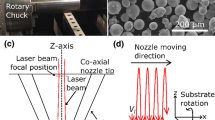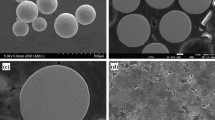Abstract
In this paper, an experimental and simulation analysis is undertaken on laser cladding of Stellite-6 on mild steel and HY80 substrates. A cladding system equipped with a coaxial powder nozzle was used to identify process parameters which would produce both favorable single-track and single-layer clads first on mild steel without the need to identify different process parameters on a per-track basis. Using the parameters from mild steel substrate cladding, a minimal amount of adjustment was shown to provide process parameters to clad Stellite-6 on HY80. Modeling of single-track clads of Stellite-6 on mild steel was performed to gain additional insight into the cladding process and was validated against two single-track conditions. It was shown that a significant amount of variability can exist in the clad geometry depending on the process parameters chosen; thus, the model provides an average portrayal of the process. Finally, based on parameter tuning during the process, cladding was found to be near-optimal when the laser beam diameter was approximately the same diameter as the powder waist diameter.





















Similar content being viewed by others
References
Zhou X, De Hosson JTM (1991) Spinel/metal interfaces in laser coated steels: a transmission electron microscopy study. Acta Metall Mater 39(10):2267–2273
Steen WM (1998) Laser surface treatment. In: Laser material processing. Springer, pp 218–271
Powell J, Henry P, Steen W (1988) Laser cladding with preplaced powder: analysis of thermal cycling and dilution effects. Surf Eng 4(2):141–149
Weerasinghe V, Steen W (1986) Laser surface cladding. In: Draper CW, Mazzoldi P (eds) Laser surface treatments of metals. Martinus Nijhoff, Dordrecht, pp 360–387
Henri P, Jonne N, Sebastian T, Jari T, Steffen N, Petri V (2012) Laser cladding with coaxial wire feeding. Int Congress Appl Lasers Electro-Opt 2012:1196–1201
Sexton L, Lavin S, Byrne G, Kennedy A (2002) Laser cladding of aerospace materials. J Mater Process Technol 122(1):63–68
Lin J, Steen W (1998) Design characteristics and development of a nozzle for coaxial laser cladding. J Laser Appl 10(2):55–63
De Oliveira U, Ocelik V, De Hosson JTM (2005) Analysis of coaxial laser cladding processing conditions. Surf Coat Technol 197(2–3):127–136
Frenk A, Vandyoussefi M, Wagniere J-D, Kurz W, Zryd A (1997) Analysis of the laser-cladding process for Stellite on steel. Metall Mater Trans B 28(3):501–508
Jeng M-C, Yan L-Y, Doong J-L (1991) Wear behaviour of cobalt-based alloys in laser surface cladding. Surf Coat Technol 48(3):225–231
Weerasinghe V, Steen W (1987) Laser cladding with pneumatic powder delivery. In: Applied laser tooling. Springer, pp 183–211
Jouvard JM, Grevey D, Lemoine F, Vannes A (1997) Continuous wave Nd: Yag laser cladding modeling: a physical study of track creation during low power processing. J Laser Appl 9(1):43–50
Ibarra-Medina J, Pinkerton AJ (2011) Numerical investigation of powder heating in coaxial laser metal deposition. Surf Eng 27(10):754–761
Pan H, Liou F (2005) Numerical simulation of metallic powder flow in a coaxial nozzle for the laser aided deposition process. J Mater Process Technol 168(2):230–244
Wen S, Shin Y, Murthy J, Sojka P (2009) Modeling of coaxial powder flow for the laser direct deposition process. Int J Heat Mass Transf 52(25–26):5867–5877
Pinkerton AJ (2007) An analytical model of beam attenuation and powder heating during coaxial laser direct metal deposition. J Phys D Appl Phys 40(23):7323
Tabernero I, Lamikiz A, Martinez S, Ukar E, De Lacalle LL (2012) Modelling of energy attenuation due to powder flow-laser beam interaction during laser cladding process. J Mater Process Technol 212(2):516–522
Partes K (2009) Analytical model of the catchment efficiency in high speed laser cladding. Surf Coat Technol 204(3):366–371
St-Georges L (2007) Development and characterization of composite Ni–Cr+ Wc laser cladding. Wear 263(1–6):562–566
Pinkerton AJ, Li L (2004) The significance of deposition point standoff variations in multiple-layer coaxial laser cladding (coaxial cladding standoff effects). Int J Mach Tools Manuf 44(6):573–584
Denney P (1991) The process development for a portable Nd: Yag laser materials processing system. Int Congress Appl Lasers Electro-Opt 1991:140–149
Singh J, Mazumder J (1987) Microstructure and wear properties of laser clad Fe− Cr− Mn− C alloys. Metall Mater Trans A 18(2):313–322
Aleshin S (1996) Coaxial single point powder feed nozzle. In: Google Patents
Hoadley A, Frenk A, Marsden C (1991) A process overview of laser hardfacing. In: Proc. I Int. Conf. Surface Engineering: Practice and Prospects, Adelaide, Australia, pp 12–14
Liu J, Li L (2005) Effects of powder concentration distribution on fabrication of thin-wall parts in coaxial laser cladding. Opt Laser Technol 37(4):287–292
Köhler H, Jayaraman V, Brosch D, Hutter F, Seefeld T (2013) A novel thermal sensor applied for laser materials processing. Phys Procedia 41:502–508
Ng G, Jarfors A, Bi G, Zheng H (2009) Porosity formation and gas bubble retention in laser metal deposition. Appl Phys A 97(3):641
Shin YC, Purdue Research Foundation (2013) Integrated laser material processing cell. US Patent 8,604,381
Lin J, Hwang B-C (1999) Coaxial laser cladding on an inclined substrate. Opt Laser Technol 31(8):571–578
Pinkerton AJ, Li L (2004) Modelling powder concentration distribution from a coaxial deposition nozzle for laser-based rapid tooling. J Manuf Sci Eng 126(1):33–41
Launder BE, Spalding DB (1983) The numerical computation of turbulent flows. In: Numerical prediction of flow, heat transfer, turbulence and combustion. Elsevier, pp 96–116
Katinas C, Shang W, Shin YC, Chen J (2018) Modeling particle spray and capture efficiency for direct laser deposition using a four nozzle powder injection system. J Manuf Sci Eng 140(4):041014
ANSYS (2009) Fluent 12.0 Theory Guide. Ansys Inc.
Liu J, Li L, Zhang Y, Xie X (2005) Attenuation of laser power of a focused Gaussian beam during interaction between a laser and powder in coaxial laser cladding. J Phys D Appl Phys 38(10):1546
Wen S, Shin YC (2010) Modeling of transport phenomena during the coaxial laser direct deposition process. J Appl Phys 108(4):044908
Kusmoko A, Dunne DP, Li H (2014) A comparative study for wear resistant of Stellite 6 coatings on nickel alloy substrate produced by laser cladding, HVOF and plasma spraying techniques. J Curr Eng Technol 4(1):32–36
Liu S, Shin YC (2019) Additive manufacturing of Ti6Al4V alloy: a review. Mater Des 164:107552
Acknowledgements
The authors wish to acknowledge the financial support of this research by Naval Engineering Education Consortium (NEEC) NUWC IHEODTD (Grant #: N00174-17-2-0001). DISTRIBUTION A. Approved for public release: distribution unlimited. NUWC Keyport #19-018.
Author information
Authors and Affiliations
Corresponding author
Additional information
Publisher’s note
Springer Nature remains neutral with regard to jurisdictional claims in published maps and institutional affiliations.
Rights and permissions
About this article
Cite this article
Katinas, C., Throop, T., Shin, Y.C. et al. Laser cladding of Stellite-6 with a coaxial nozzle via modeling and systematic experimental investigations. Int J Adv Manuf Technol 113, 837–853 (2021). https://doi.org/10.1007/s00170-021-06624-3
Received:
Accepted:
Published:
Issue Date:
DOI: https://doi.org/10.1007/s00170-021-06624-3




